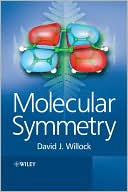Molecular Symmetry
Search in google:
Symmetry and group theory provide us with a rigorous method for the description of the geometry of objects by describing the patterns in their structure. In chemistry it is a powerful concept that underlies many apparently disparate phenomena. Symmetry allows us to accurately describe the types of bonding that can occur between atoms or groups of atoms in molecules. It also governs the transitions that may occur between energy levels in molecular systems, leading to a predictive understanding of the absorption properties of molecules and hence their spectra. Molecular Symmetry lays out the formal language used in the area, with illustrative examples of particular molecules throughout. It then applies the ideas of symmetry and group theory to describe molecular structure, bonding in molecules and to consider the implications in spectroscopy. Topics covered include: Symmetry elementsSymmetry operations and products of operationsPoint groups used with moleculesPoint group representations, matrices and basis setsReducible and irreducible representationsApplications in vibrational spectroscopyMolecular orbital theory of chemical bonding Molecular Symmetry is designed to introduce the subject by combining symmetry with spectroscopy and bonding in a clear and accessible manner. Each chapter ends with a summary of learning points, a selection of self-test questions, and suggestions for further reading. A set of appendices includes templates for paper models which will help students understand symmetry operations and cover key aspects of the material in depth. Molecular Symmetry is a must-have introduction to this fundamental topic for students of chemistry, and will also find a place on the bookshelves of postgraduates and researchers looking for a broad and modern introduction to the subject.
1 Symmetry elements and operations 1 2 More symmetry operations and products of operations 25 3 The point groups used with molecules 45 4 Point group representations, matrices and basis sets 75 5 Reducible and irreducible representations 105 6 Applications in vibrational spectroscopy 163 7 Symmetry in chemical bonding 219 App. 1 H[subscript 2]O models for identifying the results of symmetry operation products 299 App. 2 Assignment of chiral centre handedness using caha-ingold-prelog rules 303 App. 3 Model of a tetrahedron and the related cube 307 App. 4 Model of an octahedron 313 App. 5 Matrices and determinants 317 App. 6 The mathematical background to infrared selection rules 325 App. 7 The Franck-Condon principle 339 App. 8 Classical treatment of Stokes/Anti-Stokes absorption 343 App. 9 The atomic orbitals of hydrogen 345 App. 10 The origin of chemical bonding in H[subscript 2][superscript +] 375 App. 11 H[subscript 2]O molecular orbital calculation in C[subscript 2v] symmetry 401 App. 12 Character tables 407 Index 415








